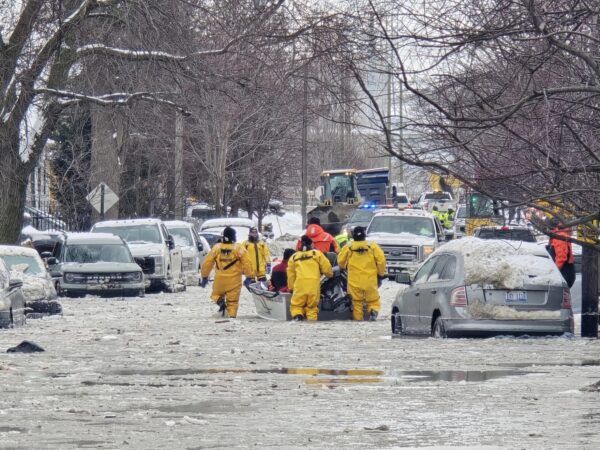
Great Lakes Moment is a monthly column written by Great Lakes Now Contributor John Hartig. Publishing the author’s views and assertions does not represent endorsement by Great Lakes Now or Detroit Public Television.
For over two decades, when you drove by the former McLouth Steel Plant in Trenton, you could not help but slow down and stare. What you saw was a complex of 45 rusting buildings with broken windows and gaping holes in the roof, and abandoned steel-making equipment and materials from a long-gone industrial era.
A 1999 Downriver Summit convened by Downriver Community Conference and the late Rep. John Dingell identified this abandoned industrial complex as the ugliest site in the region and a millstone hanging around the neck of Downriver, holding back revitalization and furthering the perception of a polluted area dominated by industrial brownfields.
Over the next nearly quarter-century, a number of redevelopment plans for the site were proposed, but none came to fruition. A 2006 plan called for residential and commercial development, and part of the site was evened zoned for mixed-use – what planners refer to as a mix of residential, commercial and/or industrial. However, it failed. In 1948, McLouth Steel bought approximately one mile of waterfront along the Trenton Channel of the Detroit River in Trenton and about two-tenths of a mile of waterfront in Riverview. For nearly a half century it was a state-of-the-art steel-making plant. It was the first plant in North America to cast 100% of its steel by the continuous caster method. But time had seemed to pass it by. Other steel companies in the United States and abroad were more competitive in steel production and it closed in 1995 after McLouth Steel filed for bankruptcy.

McLouth Steel Company, Trenton, Mich., in 1960 (Image courtesy of the City of Trenton)
The state, county and city each passed on opportunities to buy the property after Wayne County foreclosed on it in 2017 for $3.7 million. Then in 2018, Crown Enterprises, owned by the late Manuel “Matty” Moroun of the Detroit International Bridge Company that owns the Ambassador Bridge, purchased the site for $4 million from the Wayne County Land Bank. As part of the purchase agreement, Crown agreed to tear down the 45 buildings on the site within two years of the purchase and clean up some contaminated areas, and to invest $20 million within six years.
The U.S. Environmental Protection Agency, Michigan Department of Environmental Quality (now the Michigan Department of Environment, Great Lakes, and Energy), and U.S. Department of Justice approved a legal agreement involving the purchase, assessment and cleanup of the site. Residents fear that the former McLouth site will become a transportation hub of trucks, ships and trains that would increase pollution, degrade local roads, decrease property values and diminish quality of life.
All buildings have now been torn down. It is an amazing contrast to what Downriver residents saw for nearly 25 years. But the controversy is not over. Crown Enterprises wants to see the property rezoned from its current designation as mixed use to waterfront industrial. Many residents from Trenton, Grosse Ile and Riverview oppose this change, noting that in the 21st century the highest and best use of this waterfront land is not exclusively industrial. A nearly 1,000-member citizen advocacy group called Trenton Visionaries and Stakeholders has been formed to encourage environmentally friendly business and recreational revitalization of the waterfront.

Former McLouth Steel site in Trenton, Mich., in 2012. (Photo Credit: Tyler Rogers)
Critically important to the City of Trenton is its tax base. With the recent announcement of closure of the Eastman Chemical Plant in December 2020 and closure of the Trenton Channel Power Plant in 2022, there is a clear need to ensure an adequate tax base.
Complicating the issue is that in 2019 the McLouth site was designated a Superfund site, making it eligible for federal cleanup funds to aid remediation of contaminated land. This typically is a long-term process that will take many years. The Superfund program will clean up the site to standards for which the site is zoned. If it is zoned waterfront industrial, it will be cleaned up to industrial standards. If it is zoned mixed-use, it will be cleaned up to a higher standard that supports a mix of uses. Changing the designation to waterfront industrial would preclude future options that could include commercial, residential and recreational. A compromise could be that a portion of the 273-acre property be cleaned up to industrial standards and a portion could be cleaned up to the higher mixed-use standards. This could be a solution where all sides win.
What is needed is a bold vision for the former McLouth Steel site that includes industrial, commercial, residential and recreational. Cities like Cleveland, Milwaukee, Baltimore and San Diego are showing us that this is possible and that cities can indeed flourish.
Throughout the Great Lakes, cleanup of rivers and harbors is leading to reconnecting people to their waterways via greenways and water trails that is leading to waterfront revitalization, including mixed-use development.
This can be seen in Detroit with the building of the Detroit RiverWalk that achieved over a $1 billion of economic benefits in the first ten years.
Cleaning up the Buffalo River has spurred improving public access that has contributed to waterfront economic revitalization, including more than $428 million of waterfront development between 2012 and 2018.
The cleanup of the Cuyahoga River has led to the transformation of the Cleveland Flats into a community where nature, commerce, and industry live together. The Flats has seen $750 million in economic development since 2012 and another $270 million of new developments in the planning phase.
Decades of cleanup of Toronto Harbour has led to revitalization of Toronto’s waterfront with substantial economic and social benefits, including $4.1 billion in Canadian dollars in output to the Canadian economy, approximately CA$848 million in tax revenues, and about 14,100 years of employment.
There is an outstanding example of brownfield cleanup right in Trenton’s backyard with the former Chrysler brake and paint plant site on the Detroit River that was cleaned up and redeveloped into the Refuge Gateway to the Detroit River International Wildlife Refuge. The Refuge Gateway is now connected to over 50 miles of greenway trails to the south and 50 miles of greenways to the north. The Refuge Gateway and Humbug Marsh have recently opened during daylight hours Thursday through Sunday.
Visitation so far has been high considering the visitor center is not open and that it will remain closed during the COVID-19 pandemic. Between Oct. 1 and Nov. 10 the U.S. Fish and Wildlife Service estimates over 3,450 people used the fishing pier and more than 2,300 people entered Humbug Marsh across the pedestrian bridge between the Refuge Gateway and Humbug, based on data from electronic trail counters. New businesses have already opened anticipating the grand opening of the visitor center – the Grotto Pizzeria and Tavern on Van Horn Road, Elizabeth Perk on West Jefferson, and Wild Birds Unlimited at West and Allen roads.
Michael Samhat, president of Crown Enterprises, noted in an Oct. 27 virtual town hall meeting on the McLouth Steel site that Crown does not currently have any firm redevelopment plans and that it is open to options.
Downriver has a once-in-a-century opportunity to reclaim another portion of the Detroit River waterfront, improve public access, and create a more livable and sustainable community as a gift to future generations. Most communities would give their eye teeth to being located on a major river that links the upper Great Lakes with the lower Great Lakes.
A combination of industrial, commercial, residential and recreational redevelopment of the former McLouth site will make Trenton an even better community. It would be ideal if a public-private partnership could be put together with Crown Enterprises, the city, citizens and others to transform this industrial brownfield property into a 21st century model of sustainable redevelopment.
Broadening this partnership to include DTE Energy and Eastman Chemical could help find a creative solution that is a win-win-win for the economy, communities and the environment. Indeed, this is consistent with the Southern Wayne County Regional Chamber’s initiative called Destination Downriver that is promoting the region as a great place to live, work, and play.
John Hartig is a board member at the Detroit Riverfront Conservancy. He serves as the Great Lakes Science-Policy Advisor for the International Association for Great Lakes Research and has written numerous books and publications on the environment and the Great Lakes. Hartig also helped create the Detroit River International Wildlife Refuge, where he worked as the refuge manager until his retirement.
Read more Great Lakes Moments on Great Lakes Now:
Great Lakes Moment: Sacred land of the Wyandot of Anderdon Nation
Great Lakes Moment: Detroit River and western Lake Erie get a checkup
Great Lakes Moment: Cleanup of contaminated river sediment begins at old Uniroyal site
Great Lakes Moment: A tribute to Guy O. Williams, environmental justice champion
Roller Coaster: Michigan’s long history with environmental contamination
Featured image: Photo of former McLouth Steel site in Trenton, Mich., with all buildings razed, taken Nov. 23, 2020. (Photo Credit: Andy Morrison)
1 Comment
-
since no long range plans are in place for Mclouth steel mill property…. lets make it a large solar power farm. The property would still be intact for future if approved development.. Solar panels are easily installed and removed. There is a main overhead power line entering the center of property. Just something to consider.




